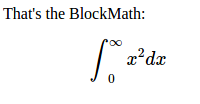@matejmazur/react-katex v3.1.3
Comparison with react-katex: https://github.com/talyssonoc/react-katex/issues/49.
Installation
$ npm install katex @matejmazur/react-katex
# or
$ yarn add katex @matejmazur/react-katexUsage
import 'katex/dist/katex.min.css';
import TeX from '@matejmazur/react-katex';Inline math
Display math in the middle of the text.
ReactDOM.render(
<TeX math="\\int_0^\\infty x^2 dx" />,
document.getElementById('math')
);
// or
ReactDOM.render(
<TeX>\int_0^\infty x^2 dx</TeX>,
document.getElementById('math')
);It will be rendered like this:

Block math
Display math in a separated block, with larger font and symbols.
ReactDOM.render(
<TeX math="\\int_0^\\infty x^2 dx" block />,
document.getElementById('math')
);
// or
ReactDOM.render(
<TeX block>\int_0^\infty x^2 dx</TeX>,
document.getElementById('math')
);It will be rendered like this:

Note: Don't forget to import KaTeX CSS file.
import 'katex/dist/katex.min.css';Error handling
Default error message
By default the error rendering is handled by KaTeX. You can optionally pass errorColor (defaults to #cc0000) as a prop:
ReactDOM.render(
<TeX math={'\\int_0^\\infty x^2 dx \\inta'} errorColor={'#cc0000'} />,
document.getElementById('math')
);This will be rendered like so:

Custom error message
It's possible to handle parse errors using the prop renderError. This prop must be a function that receives the error object and returns what should be rendered when parsing fails:
ReactDOM.render(
<TeX
math="\\int_{"
renderError={(error) => {
return <b>Fail: {error.name}</b>;
}}
/>,
document.getElementById('math')
);
// The code above will render '<b>Fail: ParseError</b>' because it's the value returned from `renderError`.This will render <b>Fail: ParseError</b>:

Custom wrapper component
You can change the wrapper component (block math uses div and inline uses span) by whatever you want via props.as attribute.
ReactDOM.render(
<TeX
math="y = x^2"
as="figcaption"
/>,
document.getElementById('math')
);Escaping expressions
In addition to using the math property, you can also quote as a child allowing the use of { } in your expression.
ReactDOM.render(
<TeX>{'\\frac{\\text{m}}{\\text{s}^2}'}</TeX>,
document.getElementById('math')
);Or Multiline
ReactDOM.render(
<TeX>{`\\frac{\\text{m}}
{\\text{s}^2}`}</TeX>,
document.getElementById('math')
);However, it can be annoying to escape backslashes. This can be circumvented with the String.raw tag on a template literal when using ES6.
ReactDOM.render(
<TeX>{String.raw`\frac{\text{m}}{\text{s}^2}`}</TeX>,
document.getElementById('math')
);Backticks must be escaped with a backslash but would be passed to KaTeX as \`. A tag can be created to replace \` with `
const latex = (...a) => String.raw(...a).replace('\\`', '`');
ReactDOM.render(<TeX>{latex`\``}</TeX>, document.getElementById('math'));You can even do variable substitution
const top = 'm';
const bottom = 's';
ReactDOM.render(
<TeX>{String.raw`\frac{\text{${top}}}{\text{${bottom}}^2}`}</TeX>,
document.getElementById('math')
);Configuring KaTeX
You can change directly all KaTeX options via props.settings:
Example of adding a custom macro:
ReactDOM.render(
<TeX settings={{ macros: { '*': '\\cdot' } }}>y = k * x + c</TeX>
);Result:

5 years ago
5 years ago
5 years ago
5 years ago
7 years ago
7 years ago
7 years ago
7 years ago
7 years ago
7 years ago
7 years ago
7 years ago
7 years ago
7 years ago
7 years ago
7 years ago
7 years ago
7 years ago
7 years ago
7 years ago
7 years ago
7 years ago
7 years ago
7 years ago
7 years ago
